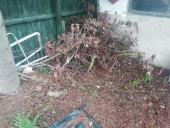posted 15 years ago
i have found that the best way to garden under full size adult trees is to poke down with a metal rod and find out where the roots actually are, if they aren't visible.
then use something like a post hole digger and dig out the are where you want to plant and plant in that hole..if the tree has a lot of small surface roots you might want to plant in a bottomless pot large enough to contain the fullsize of the mature plant that you are planting, this will prevent the tree roots from coming into the planting zone..or at least help.
however..a mature tree generally has it's feeder roots out more toward the drip line ..so you should be able to plant a shrub or understory tree under your mature tree, or even some shade lovers..like hostas etc..with no problem
i would feed the holes generously.
i have plants growing under all of my large adult trees, but i suit the plant to the tree situation and the openness of the situation.
under the deep shade of evergreens or low branched heavy shaded trees here i have things growing like hostas, solomons seal, lily of the valley , aegopodium, ..those with higher branches i have things like lilacs and elderberry and snowberry, and mock orange growing under very large established trees, i also have some vines growing up and through large trees like fox grapes, woodbine and clematis. There are currants and berries growing under some of my trees, and i have things like daylillies and iris and other perennials growing on the sunnier side of trees but under their driplines..in more open situations..it is always best to not have grass under your trees.
one thing i have found helpful is to work with what the tree produces..if it produces needles..you can pile the needles under the tree and grow your plants right in the needles..i have aegopodium and columbine and blueberries growing in pine needles..and then also under some maple trees i rake all the maple leaves back under the tree, it makes a great mulch and feeds the tree and also makes a base for growing things in..there are perennials and ground covers like aegopodium as well as shrubs growing out of this medium under my maple trees.
Brenda
Bloom where you are planted.
http://restfultrailsfoodforestgarden.blogspot.com/






































